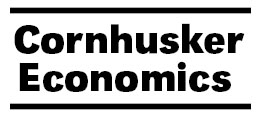Agricultural Economics, Department of

Cornhusker Economics
Date of this Version
3-19-2008
Document Type
Newsletter Issue
Citation
Cornhusker Economics
Abstract
The average value of Nebraska farmland rose 23 percent over the past 12 months, the steepest annual percentage gain ever recorded in the 30-year history of the University of Nebraska-Lincoln Nebraska Farm Real Estate Market Survey (Figure 1 and Table 1). Preliminary results place the state’s all-land average value at $1,425 per acre as of February 1, 2008. This gain, combined with the gains of the past four years, puts the current all-land average value more than 88 percent higher than the 2003 level. Today’s level represents a new historical peak value, not only in nominal terms but also in real (inflation-adjusted) terms — the previous peak in inflation-adjusted dollars was in 1981, just prior to a major asset devaluation during the farm-crisis years of the mid-1980s.
Strong crop commodity prices during 2007, even prior to the recent run-up since the first of the year, sent economic returns to cropland to record levels. That, and market participants’ expectation of continued robust earnings, contributed to spirited bidding on land.
The underlying causes of this new plateau are fairly obvious. Corn demand from the rapidly growing ethanol industry in the state (Nebraska ranks #2 in production), fueled prosperous returns across the corn producing areas of the state. This, in combination with rising world demand for essentially all Nebraska-grown commodities, has created a phenomenal income effect across the entire state. And true to economic logic, those income signals get capitalized into agricultural land values relatively quickly.


Comments
Published in Cornhusker Economics, 3-19-08. Produced by the Cooperative Extension, Institute of Agriculture and Natural Resources, Department of Agricultural Economics, University of Nebraska – Lincoln. http://www.agecon.unl.edu/Cornhuskereconomics.html